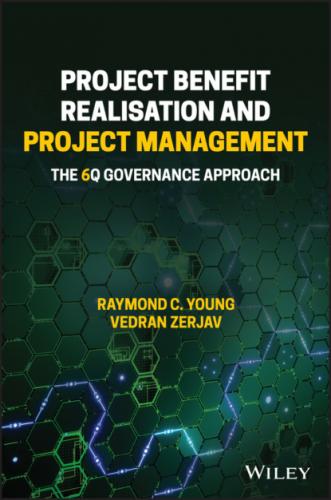Figure 3.7: A weak AcdB logic.
Figure 3.8: Initial value chain.
Figure 3.9: Enhanced value chain.
Figure 3.10: Value chain enhanced with projects identified through influencer analysis.
Figure 3.11: Prototype project reports.
Figure 3.12: Screenshot of step 1 of the project initiation process – business case. Source: DSTG.
Figure 3.13: Prototype project portfolio management reports at DSTG.
Figure B.1: Project governance structure. Source: Young, 2005.
Figure B.2: Project timeline. Source: Young, 2005.
Preface
As we are writing this handbook, the COVID‐19 crisis is unfolding, creating challenges and opportunities of unprecedented scale for the economies and societies around the world. A number of projects are having their budgets axed and objectives put on hold but at the same time, many new projects are being initiated to help us all prepare to function and live in the ‘new normal’. Project sponsors, investors, and financiers are taking a risk‐averse view as to what projects will be needed and what to support in the post‐pandemic ‘brave new world’. Indeed, we felt that this handbook is a timely response to the challenges of this situation, focusing on project benefits and the design of projects in the light of their benefits, rather than the conventional criteria of project success.
Our ambition is to help organisational project clients and their project executives navigate these uncertain times. The book is deliberately brief and written for Corporate Boards and their ‘accidental project sponsors’. Managers do not suddenly acquire the knowledge to govern a big project when they are promoted to senior management. It is far more common to be delegated the role and to become a project sponsor by ‘accident’. Once delegated, the common experience is to find most of the advice one is given is not helpful, and success or failure becomes dependent on your instincts as a project sponsor. In the post‐pandemic world, projects are more critical to the survival of organisations and we cannot fall back on such a hit‐and‐miss approach. This handbook addresses this issue by distilling the experience of senior managers and presenting guidance in the form of six key questions illustrated by case studies.
The guidance is informed by decades of research and has been tested against a database of hundreds of projects to confirm its effectiveness. It is also supported by a companion website (www.6qgovernance.com) where readers can read the latest insights and post questions to the authors and their peers to get timely advice on how to govern their projects for the new normal.
Authors CV
Raymond C. Young – Career Summary
Raymond Young is an international authority in project governance. His research has been published by Standards Australia as HB280‐2006, a handbook explaining how boards and top managers influence business projects to succeed. His career objective is to help clients realise strategic business benefits from their projects rather than to simply come in on‐time on‐budget.
Raymond is a Fellow of the Australian Institute of Project Management (FAIPM) and a Fellow of the Governance Institute of Australia (FGIA). He is a founding member of the committee that developed the Australian and international governance standards AS8016 and ISO38500. Raymond’s career alternates between industry and academia. He has recently taken up a Senior Associate Professor role at Xi’an Jiaotong‐Liverpool University in Suzhou, China after a lengthy period as an academic at both the University of New South Wales and the University of Canberra. He has a decade of management consulting experience culminating in a CIO role within Fujitsu Australia.
Until recently, Raymond has been advising Australian Federal Government agencies on how to improve their project, programme, and portfolio management practices. His other expertise includes performance measurement, business process reengineering, activity‐based management, and logistics. His significant clients have included Colgate‐Palmolive, BHP, Commonwealth Bank of Australia, Telstra, Department of Health, Electricity Trust of South Australia, and Prospect Electricity.
Qualifications and Accreditations
Fellow of the Governance Institute of Australia (FGIA)
Fellow of the Australian Institute of Project Management (FAIPM)
Graduate of the Australian Institute of Company Directors (GAICD)
Doctor of Philosophy (PhD), Macquarie Graduate School of Management, Macquarie University, 2006
Master of Business Administration (MBA), University of Sydney, 1988–1992
Graduate Diploma in Education (DipEd), Sydney College of Advanced Education, 1986
Bachelor of Building Science (BBSc), Victoria University of Wellington, New Zealand, 1982–1984
Work History
| 2019–current | Senior Associate Professor Xi’an Jiaotong‐Liverpool University |
| 2016–2019 | Senior Lecturer University of NSW, Canberra |
| 2010–2016 | Assistant Professor University of Canberra |
| 2008–2010 | Practice Lead, Project Governance e8 Consulting |
| 2002–2008 | Lecturer Macquarie University |
| 1994–1998 | CIO Fujitsu Australia & FBA Computer Technology Services |
| 1991–1994 | Management Consultant Deloitte Touche Tohmatsu |
Vedran Zerjav – Career Summary
Vedran Zerjav is an Associate Professor of Infrastructure Project Management in the Bartlett, UCL. He is a scholar of projects with an interest in a range of organisational issues in project‐based organisational forms. His main areas of interest include strategic, operational, and value considerations in projects and his empirical focus is on urban infrastructure and its delivery. He is a qualitative researcher with an interest in hybrid and novel methodologies for project studies. Vedran’s engagement with the world of project management practice is extensive and spans research and advisory roles working with major infrastructure clients and professional bodies such as the Association for Project Management and Project Management Institute.
Qualifications
Doctor of Technical Sciences (Dr.techn.), Vienna University of Technology, 2012
Diploma in Civil Engineering (Dipl.ing./M.Eng.), University of Zagreb, 2006
Work History
| 2014–Present |
University College London, Bartlett School of Construction and Project
|
